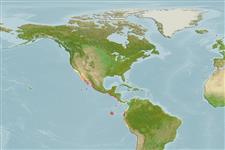Classificação / Names
Common names from other countries
Referência principal
Tamanho / Peso / Idade
Max length : 84.0 cm FL macho/indeterminado; (Ref. 168); common length : 60.0 cm FL macho/indeterminado; (Ref. 9340); Peso máx. publicado: 9.1 kg (Ref. 168)
Ambiente
; marinhas; oceanódromo (Ref. 51243); intervalo de profundidade 0 - 40 m (Ref. 5227)
Clima / Intervalo
Tropical, preferred 28°C (Ref. 107945); 39°N - 16°S, 128°W - 77°W (Ref. 168)
Distribuição
Eastern Pacific: off San Simeon, California, USA southward to the Galapagos Islands and northern Peru. Two stray specimens collected in the Hawaiian Islands.
Países | Áreas FAO | Ecossistemas | Ocorrências | Introduções
Descrição breve
Espinhos dorsais (total): 10 - 15; Raios anais moles: 11 - 12; Vértebras: 37. Anterior spines of first dorsal fin much higher than those mid-way, giving the fin a strongly concave outline. Interpelvic process small and bifid. Body naked except for corselet and lateral line. Swim bladder absent. A large rounded protuberances on 31st and 32nd vertebrae. Color is generally iridescent blue with black dorsal markings composed of 3 to 5 horizontal stripes. Also with variable black or dark gray spots above the pelvic fins. Occasionally with extensive longitudinal stripes of light gray on belly; some individuals have few or no belly markings.
Categoria na Lista Vermelha da IUCN (Ref. 115185)
Ameaça para o homem
Harmless
Utilização humana
Pescarias: pouco comercial; peixe desportivo: sim
Mais informação
ReferênciasAquaculturaPerfil para aquaculturaEstirpesGenéticaFrequência dos alelosHereditariedadeDoençasProcessamentoMass conversion
Ferramentas
Relatórios especiais
Descarregue XML
Fontes da internet
Estimates of some properties based on models
Phylogenetic diversity index
PD50 = 0.6250 many relatives (e.g. carps) 0.5 - 2.0 few relatives (e.g. lungfishes)
Nível Trófico
3.8 ±0.60 se; Based on food items.
Resiliência
Médio, tempo mínimo de duplicação da população 1,4 - 4,4 anos (Assuming tm=2)
Vulnerabilidade
Moderate vulnerability (44 of 100)
Categoria de preço
